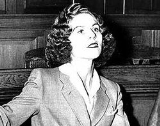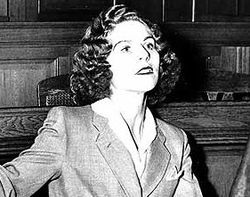
Stella Kübler
Encyclopedia

Collaborationism
Collaborationism is cooperation with enemy forces against one's country. Legally, it may be considered as a form of treason. Collaborationism may be associated with criminal deeds in the service of the occupying power, which may include complicity with the occupying power in murder, persecutions,...
with the Gestapo
Gestapo
The Gestapo was the official secret police of Nazi Germany. Beginning on 20 April 1934, it was under the administration of the SS leader Heinrich Himmler in his position as Chief of German Police...
during World War II
World War II
World War II, or the Second World War , was a global conflict lasting from 1939 to 1945, involving most of the world's nations—including all of the great powers—eventually forming two opposing military alliances: the Allies and the Axis...
, exposing and denouncing Berlin's underground Jews.
Early life
She was born Stella Goldschlag and raised in BerlinBerlin
Berlin is the capital city of Germany and is one of the 16 states of Germany. With a population of 3.45 million people, Berlin is Germany's largest city. It is the second most populous city proper and the seventh most populous urban area in the European Union...
as the only child in a middle-class, assimilated Jewish family. After the seizure of power by the Nazis, she, like other Jewish children, was forbidden to go to public school, so she attended Goldschmidt, a school set up by the Jewish community, where she was known for her beauty and vivacity.
Her parents attempted to leave Germany to escape the Reich, but were unable to get visas for other countries. The family fell on hard times when Jews were purged from positions of influence and her father lost his job with the newsreel company Gaumont. After Stella completed her education she trained as a fashion designer at the School of Applied Art in Nurnbergerstrasse.
Going underground and collaboration
In 1941, she married a Jewish musician, Manfred Kübler. They had met when both were working as Jewish forced-labourers in a war plant in Berlin. In about 1942, when the large deportation programme of Berlin Jews into extermination camps began, she disappeared underground, using forged papers to pass as a non-Jew—an endeavour helped by her blonde-haired, blue-eyed, classically beautiful, 'Aryan' appearance.In the spring of 1943, she and her parents were arrested by the Nazis, but to avoid deportation for herself and her parents, agreed to become a "catcher" for the Gestapo, hunting down Jews hiding as non-Jews (referred to as "U-Boats"). She proceeded to comb Berlin for such Jews and, as she was familiar with a large number of Jewish people from her years at her segregated Jewish school, Kübler was very successful at finding her former schoolmates and handing their information over to the Gestapo, while pretending to be a U-Boat herself. The data concerning the number of her victims varies, depending on different sources of information, from between 600 to 3000 Jews. Kübler's charisma and striking good looks were a great advantage in her pursuit of underground Jews. The Nazis called her "blonde poison". She is mentioned in The Forger, Cioma Schonhaus' 2004 account of living as an underground Jew in Berlin.
Despite her collaboration, the Nazis eventually deported her parents to a concentration camp, where they were killed. Her husband was deported in 1943 to Auschwitz, along with his family. This did not prevent Kübler from continuing her work as a Catcher for the Gestapo. She continued this work until March 1945. During this time, she met and married Rolf Isaaksohn, also Jewish.
Post-war
At the end of the war she went into hiding, but was found and arrested by the Soviets in October 1945 and sentenced to ten years' camp detention. Afterwards she moved to West BerlinWest Berlin
West Berlin was a political exclave that existed between 1949 and 1990. It comprised the western regions of Berlin, which were bordered by East Berlin and parts of East Germany. West Berlin consisted of the American, British, and French occupation sectors, which had been established in 1945...
. There she was again tried and convicted, and punished with ten years' detention. However she did not have to serve that sentence because of time already served in the Soviet prison. In 1992, Peter Wyden, a Berlin schoolmate whose family had been able to get visas for the US in 1937 and who later learned about Stella's role as a Catcher while he was working for the U.S. Army, wrote a biography of Kübler.
She suffered from severe depression due to her loneliness and guilt because of her activities during the war. She committed suicide
Suicide
Suicide is the act of intentionally causing one's own death. Suicide is often committed out of despair or attributed to some underlying mental disorder, such as depression, bipolar disorder, schizophrenia, alcoholism, or drug abuse...
in 1994 by jumping from the window of her apartment.
Sources
- Wyden, Peter: Stella. New York: Simon & Schuster, 1992
- Gross, Leonard. The Last Jews in Berlin. New York: Simon and Schuster, 1982. ISBN 0671247271.

